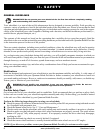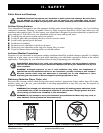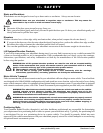
Litestream Junior www.pridemobility.com 13
Positioning belts should be installed as detailed in this manual. See IV. “Comfort Adjustments.” Once installed,
the belt should be placed across the pelvis as determined by your healthcare provider. Anchor points of the posi-
tioning belts should be located so that a projected side-view angle of the pelvis is between 45°-75° of horizontal
depending on the user’s weight, posture, and seat cushion thickness.
WARNING! If you require a positioning belt to safely operate your wheelchair, make sure it is
fastened securely in order to reduce the possibility of a fall from the wheelchair.
WARNING! The positioning belt is not designed for use as a seat belt in a motor vehicle. Nor is
your wheelchair suitable for use as a seat in any vehicle. Anyone traveling in a vehicle should
be properly belted into seats approved by the vehicle manufacturer.
Removable Parts
WARNING! Do not attempt to lift or move a wheelchair by any of its removable parts, including
the armrests, seat, and front riggings. Do not attempt to pick up the wheelchair while the seat
is occupied. Pride recommends use of only solid, non-removable frame components to lift or
move your wheelchair.
Reaching and Bending
Never reach, lean, or bend while driving your wheelchair. If it is absolutely necessary to reach, lean, or bend while
seated on your wheelchair, it is important to maintain a stable center of gravity and keep the wheelchair from
tipping. Pride recommends that the wheelchair user determine his/her personal limitations and practice bending
and reaching in the presence of a qualified healthcare professional.
WARNING! Do not bend, lean, or reach for objects if you have to pick them up from the
floor by reaching down between your knees or if you have to reach over the back of the
seat. Movements such as these may change your center of gravity and the weight
distribution of the wheelchair. This may cause your wheelchair to tip.
WARNING! Keep your hands away from the tires when driving. Be aware that loose
fitting clothing can become caught in drive tires.
II. SAFETY
Figure 4. Ideal Transfer Position
Transfers
Transferring onto and off of your wheelchair requires a
good sense of balance and agility. It is dangerous to
transfer on your own. Always have an attendant or
healthcare professional present while learning to prop-
erly transfer yourself. To avoid a fall, be aware that there
is a point during every transfer when the wheelchair is
not below you.
To eliminate the possibility of injury, Pride recommends
that you or a trained attendant perform the following
tasks before attempting a transfer:
Turn both caster wheels toward the transfer destination
to improve wheelchair stability during transfer.
Ensure both wheel locks on your wheelchair are
engaged. See III. “Your Wheelchair.”
NOTE: This will not keep your wheelchair from sliding
away from you or tipping.
If necessary, remove or flip up one or both armrests.
See IV. “Comfort Adjustments.”


















